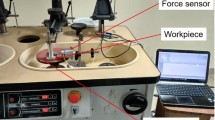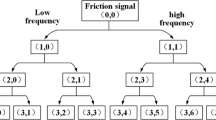Abstract
Quantification of friction may provide insights into the material removal behavior of polishing process. In this study, frictional force at the workpiece-polisher interface is measured using customised instrumentation setup (miniature load cell: 0–25 lbf) at different combinations of process parameters during polishing of BK7 optical glass. It is observed that frictional force varies with polishing time and is also a function of process parameters. It is observed that friction coefficient (~0.1) indicates the ductile material removal from the workpiece surface while friction coefficient (~0.3) indicates ductile cum brittle fracture behavior, which is also verified through surface texture observed through optical interferometer. Friction coefficient indicates that workpiece and polisher surfaces are in solid-solid contact mode. Hence, mechanical actions are dominant over chemical actions in removing the material from workpiece surface. Further variation of surface parameters w.r.t. wear index is estimated and way to enhance the polishing process efficiency is suggested.
Similar content being viewed by others
References
R. K. Pal, H. Garg, R. V. Sarepaka and V. Karar, Experimental investigation of material removal and surface roughness during optical glass polishing, Materials and Manufacturing Processes, 31 (12) (2016) 1613–1620.
A. Singh, H. Garg, P. Kumar and A. K. Lall, Analysis and optimization of parameters in optical polishing of large diameter BK7 flat components, Materials and Manufacturing Processes, 32 (5) (2017) 542–548.
S. Kumar and A. K. Singh, Magnetorheological nanofinishing of BK7 glass for lens manufacturing, Materials and Manufacturing Processes, 33 (11) (2017) 1188–1196.
R. K. Pal, H. Garg and V. Karar, Material removal characteristics of full aperture optical polishing process, Machining Science and Technology, 21 (4) (2017) 493–525.
V. K. Jain, A. Sidpara, M. R. Sankar and M. Das, Nanofinishing techniques: A review, Proceedings of the Institution of Mechanical Engineers, Part C: Journal of Mechanical Engineering Science, 226 (2) (2011) 327–346.
T. Yu, H. Li and W. Wang, Experimental investigation on grinding characteristics of optical glass BK7: With special emphasis on the effects of machining parameters, The International Journal of Advanced Manufacturing Technology, 82 (5) (2016) 1405–1419.
P. A. Baisden, L. J. Atherton, R. A. Hawley, T. A. Land, J. A. Menapace, P. E. Miller, M. J. Runkel, M. L. Spaeth, C. J. Stolz, T. I. Suratwala, P. J. Wegner and L. L. Wong, Large optics for the national ignition facility, Fusion Science and Technology, 69 (1) (2016) 295–351.
T. E. Fischer and W. M. Mullins, Chemical aspects of ceramic tribology, Journal of Physical Chemistry, 96 (14) (1992) 5690–5701.
H. Tomizawa and T. E. Fischer, Friction and wear of silicon nitride and silicon carbide in water: Hydrodynamic lubrication at low sliding speed obtained by tribochemical wear, ASLE Transactions, 30 (1) (1987) 41–46.
V. Koushik, M. Anirban, Y. Ho and C. Srinivasan, Surface phenomena revealed by in situ imaging: studies from adhesion, wear and cutting, Surface Topography: Metrology and Properties, 5 (1) (2017) 014002.
T. Reye, Zur Theorie der Zapfenreibung (Theory of pivot friction), Der Civilingenineur (Journal of Civil Engineering), 4 (1860) 235–255.
J. F. Archard, Contact and rubbing of flat surfaces, Journal of Applied Physics, 24 (8) (1953) 981–988.
T. I. Suratwala, M. D. Feit and W. A. Steele, Toward deterministic material removal and surface figure during fused silica pad polishing, Journal of the American Ceramic Society, 93 (5) (2010) 1326–1340.
C. J. Evans, E. Paul, D. Dornfeld, D. A. Lucca, G. Byrne, M. Tricard, F. Klocke, O. Dambon and B. A. Mullany, Material removal mechanisms in lapping and polishing, CIRP Annals -Manufacturing Technology, 52 (2) (2003) 611–633.
J. Y. Lai, Mechanics, mechanisms, and modeling of the chemical mechanical polishing process, Department of Mechanical Engineering, Massachusetts Institute of Technology (2001) 308.
R. K. Pal, H. Garg and V. Karar, Full aperture optical polishing process: Overview and challenges, D. K. Mandal, C. S. Syan (Eds.), CAD/CAM, Robotics and Factories of the Future, Springer, India (2016) 461–470.
J. Yu, H. He, Y. Zhang and H. Hu, Nanoscale mechanochemical wear of phosphate laser glass against a CeO2 particle in humid air, Applied Surface Science, 392 (2017) 523–530.
J. Yu, W. Yuan, H. Hu, H. Zang, Y. Cai and F. Ji, Nanoscale friction and wear of phosphate laser glass and BK7 glass against single CeO2 particle by AFM, Journal of the American Ceramic Society, 98 (4) (2015) 1111–1120.
G. Savio, R. K. Pal, R. Meneghello, L. D'Angelo and G. Concheri, Shape and curvature error estimation in polished surfaces of ground glass molds, Optical Engineering, 56 (2) (2017) 024101–024101.
F. W. Preston, The theory and design of plate glass polishing machine, J. Soc. Glass Technol., 11 (44) (1927) 214–256.
Y. Homma, Dynamical mechanism of chemical mechanical polishing analyzed to correct preston’s empirical model, Journal of The Electrochemical Society, 153 (6) (2006) G587–G590.
G. Savio, R. Meneghello and G. Concheri, A surface roughness predictive model in deterministic polishing of ground glass moulds, International Journal of Machine Tools and Manufacture, 49 (1) (2009) 1–7.
N. Belkhir, T. Aliouane and D. Bouzid, Correlation between contact surface and friction during the optical glass polishing, Applied Surface Science, 288 (2014) 208–214.
N. Belkhir, D. Bouzid and V. Herold, Determination of the friction coefficient during glass polishing, Tribology Letters, 33 (1) (2009) 55–61.
A. Kelm, R. Boerret and S. Sinzinger, Improving the polishing accuracy by determining the variance of the friction coefficient, Journal of the European Optical Society-Rapid publications, 7 (12049) (2012) 1–4.
Author information
Authors and Affiliations
Corresponding author
Additional information
Recommended by Associate Editor Yongho Jeon
Raj Kumar Pal is a Scientist in the Department of Optical Devices and Systems at CSIR-Central Scientific Instruments Organisation (CSIR-CSIO), Chandigarh (India). He received M.Tech. in Advanced Instrumentation Engineering in 2011 from Academy of Scientific and Innovative Research, CSIR-CSIO Campus, Chandigarh and B.Tech in Mechanical Engineering in 2008 from Vellore Institute of Technology University, Vellore, Tamil Nadu (India). His areas of interests are optical design, optical fabrication, and precision opto-mechanical system development. He is a member of OSA, SPIE, OSI, IETE, and IAENG.
Raj Kumar Pal is a Scientist in the Department of Optical Devices and Systems at CSIR-Central Scientific Instruments Organisation (CSIR-CSIO), Chandigarh (India). He received M.Tech. in Advanced Instrumentation Engineering in 2011 from Academy of Scientific and Innovative Research, CSIR-CSIO Campus, Chandigarh and B.Tech in Mechanical Engineering in 2008 from Vellore Institute of Technology University, Vellore, Tamil Nadu (India). His areas of interests are optical design, optical fabrication, and precision opto-mechanical system development. He is a member of OSA, SPIE, OSI, IETE, and IAENG. Rohit Sharma is a Research Scholar at CSIR-CSIO Chandigarh. He did his bachelor in Mechanical Engineer from Himachal Pradesh University and obtained Masters in Engineering from PEC University of Technology, Chandigarh. His research areas are Precision Machining, Advance Manufacturing, Diamond Turning, Surface characterization. He has 5+ years of work experience in R & D institute and 2 years of teaching experience. He has 10 + publications in various International & national journals & conference proceedings.
Prabhat Kumar Baghel is currently working as Senior Scientist in Department of Optical devices and systems at CSIR-Central Scientific Instruments Organisation, Chandigarh, India. HE had received Master of Technology in Optoelectronics in 2003 and Bachelor of Engineering in Electronics and Telecommunication. His research interest is in the field of optics and photonics particularly in precision optical fabrication using non-conventional techniques.
Harry Garg (Ph.D. Mechanical) is working as a Senior Scientist in CSIRCSIO, Chandigarh. He is having 10+ years of experience in the field of Research and Development for Strategic and Defence instrumentation. His research activities include R&D in the area of optics, photonics, mechanical, thermal and electronic modules. Another areas of research are ferro-fluids for cooling systems, deterministic grinding and polishing and many more. He has 15+ publications in various national and international journals and conference proceedings.
Vinod Karar is presently working as Senior Principal Scientist, Coordinator & Professor, Academy of Scientific & Innovative Research (AcSIR-CSIO), and Head, Optical Devices & Systems, CSIR-Central Scientific Instruments Organisation, Chandigarh, India. His areas of expertise are Avionics, Optical Devices and Systems, Optronics, and System Engineering. He completed his Ph.D. (engineering) from Thapar University, Patiala, India; ME (electronics engineering) from Punjab Engineering College (presently known as PEC University of Technology), Chandigarh, India; and BE (electronics engineering) from Maulana Azad Regional Engineering College now known as Maulana Azad National Institute of Technology), Bhopal, India. He joined CSIR-CSIO Chandigarh in July 1993. He has handled more than 14 R&D projects of national importance and developed more than 14 technologies for strategic, medical and industrial applications. He has more than 150 technology documents, 140 journal and conference publications, 01 patent and 01 book chapter to his credit. He has guided more than 250 UG, 32 PG and 12 PhD students. He has received several technology awards. He is a fellow of IETE, IEI, OSI, ASI, Member of IEEE, OSA, and various other professional bodies.
Rights and permissions
About this article
Cite this article
Pal, R.K., Sharma, R., Baghel, P.K. et al. An approach for quantification of friction and enhancing the process efficiency during polishing of optical glass. J Mech Sci Technol 32, 3835–3842 (2018). https://doi.org/10.1007/s12206-018-0735-2
Received:
Revised:
Accepted:
Published:
Issue Date:
DOI: https://doi.org/10.1007/s12206-018-0735-2




